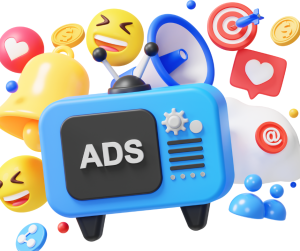The realm of advertising stands at the forefront of innovation. As brands strive to make meaningful connections with their target audiences in a fast-paced digital age, the traditional methods of advertising have metamorphosed into a dynamic tapestry of creativity and strategy. Enter a new era where advertising transcends mere promotion; it now embodies a symphony of storytelling, engagement, and interaction that speak directly to the hearts and minds of consumers. Imagine a world where adverts are not interruptions but rather captivating narratives that seamlessly blend into our daily lives. This blog post delves deep into the paradigm shift of advertising, exploring how brands are now carving out unique ways to connect with their audiences on a profound level. From immersive brand experiences to personalized content tailored to individual preferences, the concept of advertising has truly evolved into an art form that resonates with consumers on a personal and emotional level. Join us on a journey through the intricacies of this advertising revolution, where creativity knows no bounds and brands are forging authentic connections like never before. Welcome to a new dawn where advertising isn’t just about selling a product; it’s about creating experiences that leave a lasting impression.
The Rise of Storytelling in Advertising
One of the most significant shifts in advertising is the rise of storytelling as a powerful tool for brands to connect with their audiences. Gone are the days of simple product-centric advertisements; now, brands are creating compelling narratives that engage and captivate consumers. By weaving stories into their marketing campaigns, brands can evoke emotions, build relationships, and leave a lasting impact on their target audience.
Storytelling allows brands to go beyond selling products and services; it enables them to create an emotional connection with consumers. Through well-crafted narratives, brands can tap into universal human experiences and values, making their messages relatable and memorable. By telling stories that resonate with their target audience’s aspirations, dreams, or challenges, brands can position themselves as allies or guides on the consumer’s journey.
Moreover, storytelling provides an opportunity for brands to differentiate themselves from competitors in a crowded marketplace. By crafting unique narratives that reflect their brand identity and values, companies can stand out and establish a distinct voice in the minds of consumers. This not only helps build brand loyalty but also fosters a sense of authenticity and trust.
With the advent of digital platforms and social media, storytelling has become even more powerful. Brands can now leverage various mediums such as videos, podcasts, or interactive content to bring their stories to life. These immersive experiences allow consumers to engage with the brand on a deeper level and actively participate in the narrative.
In conclusion, storytelling has emerged as a game-changer in advertising. By leveraging this powerful tool, brands can create meaningful connections with their audiences by tapping into emotions, differentiating themselves from competitors, and fostering authenticity. As advertising continues to evolve, storytelling will remain at its core as an essential element for connecting with consumers in new ways.
Leveraging Technology for Targeted Engagement
In today’s digital age, technology plays a crucial role in advertising. Brands are leveraging various technological advancements to deliver targeted and personalized messages to their audiences. This shift towards data-driven advertising allows brands to reach the right people, at the right time, with the right message.
One of the key technologies transforming advertising is artificial intelligence (AI). AI-powered algorithms analyze vast amounts of consumer data to identify patterns, preferences, and behaviors. This enables brands to create highly targeted campaigns that resonate with specific audience segments. By understanding consumer interests and preferences, brands can deliver personalized content that captures attention and drives engagement.
Another technology reshaping advertising is programmatic advertising. Programmatic platforms automate the buying and selling of ad inventory in real-time. This allows brands to optimize their ad placements based on factors such as audience demographics, location, or browsing behavior. By delivering ads to the most relevant audiences across multiple channels, brands can maximize their reach and impact.
Furthermore, technology has enabled interactive advertising experiences that engage audiences in real-time. Augmented reality (AR) and virtual reality (VR) technologies have opened up new possibilities for brands to create immersive brand experiences. Through AR filters or VR simulations, consumers can interact with products or explore virtual environments, creating memorable brand interactions.
In conclusion, technology has revolutionized advertising by enabling targeted engagement and personalized experiences. AI-driven insights help brands understand their audiences better and deliver tailored messages that resonate with individuals. Programmatic platforms optimize ad placements for maximum impact, while AR and VR technologies offer immersive experiences that captivate consumers.
Interactive Campaigns: Engaging Audiences in Real-Time
Gone are the days when advertisements were one-way communications from brands to consumers; today’s advertising landscape is all about interactivity. Brands are embracing interactive campaigns that allow audiences to actively participate and engage with the brand in real-time.
One popular form of interactive advertising is gamification. Brands are incorporating game elements into their campaigns to make them more engaging and enjoyable for consumers. By turning advertisements into interactive games, brands can capture attention, encourage participation, and create memorable experiences. Gamification also fosters a sense of competition or achievement, further motivating consumers to interact with the brand.
Social media platforms have also played a significant role in driving interactive advertising. Brands leverage features such as polls, quizzes, or challenges to encourage audience participation and generate user-generated content. By involving consumers in the creation or co-creation of content, brands can foster a sense of ownership and community.
Live streaming is another powerful tool for real-time engagement. Brands can host live events or product launches that allow audiences to interact directly through comments or questions. This creates a sense of immediacy and exclusivity, making consumers feel connected to the brand in real-time.
In conclusion, interactive campaigns have become an integral part of modern advertising strategies. By embracing interactivity through gamification, social media engagement, or live streaming events, brands can create immersive experiences that captivate audiences and foster a sense of connection.
Embracing Influencer Marketing Strategies
Influencer marketing has emerged as a powerful strategy for brands to connect with their target audiences authentically. Instead of relying solely on traditional advertising methods, brands are partnering with influencers who have established credibility and influence within specific niches or communities.
By collaborating with influencers, brands can tap into their existing fan base and leverage their influence to promote products or services effectively. Influencers provide an authentic voice that resonates with their followers, making the brand message more relatable and trustworthy.
Moreover, influencer marketing allows brands to reach highly targeted audiences. By carefully selecting influencers whose followers align with the brand’s target demographic, brands can ensure that their message reaches the right people. This targeted approach increases the chances of engagement and conversion.
Additionally, influencer marketing offers a more organic and native advertising experience. Instead of interrupting consumers with traditional ads, influencer collaborations seamlessly integrate the brand message into the influencer’s content. This creates a more natural and non-intrusive advertising experience for consumers.
In conclusion, influencer marketing has become an essential component of modern advertising strategies. By partnering with influencers, brands can tap into their credibility and influence to connect with target audiences authentically.
Conclusion: Redefining Brand-Audience Relationships
The evolution of advertising has redefined the relationship between brands and their audiences. No longer are consumers passive recipients of brand messages; they have become active participants in the advertising process.
Through storytelling, technology-driven engagement, interactive campaigns, and influencer marketing strategies, brands are forging authentic connections with their audiences. Advertising is no longer just about selling products; it’s about creating experiences that resonate on a personal and emotional level.
As we move forward in this new era of advertising, creativity will continue to be at the forefront. Brands must constantly innovate and find new ways to engage their audiences genuinely. By embracing these evolving trends and strategies, brands can create meaningful connections that leave a lasting impression.
In conclusion, advertising has evolved into a dynamic blend of creativity, strategy, and technology that connects with audiences in new ways. The rise of storytelling, leveraging technology for targeted engagement, interactive campaigns, and embracing influencer marketing have all contributed to this transformation. As brands continue to redefine their relationships with audiences through innovative approaches to advertising, they will shape the future landscape of marketing communication.
Steal Our Customers offers dynamic advertising and marketing strategies, specializing in SEO, pay-per-click, and retargeting, to help businesses outperform competitors and thrive in their markets.






